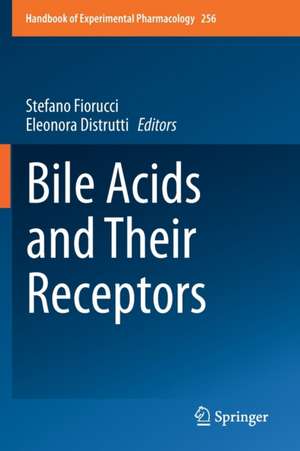Bile Acids and Their Receptors: Handbook of Experimental Pharmacology, cartea 256
Editat de Stefano Fiorucci, Eleonora Distruttien Limba Engleză Paperback – 19 sep 2020
| Toate formatele și edițiile | Preț | Express |
|---|---|---|
| Paperback (1) | 783.92 lei 6-8 săpt. | |
| Springer International Publishing – 19 sep 2020 | 783.92 lei 6-8 săpt. | |
| Hardback (1) | 1106.50 lei 6-8 săpt. | |
| Springer International Publishing – 19 sep 2019 | 1106.50 lei 6-8 săpt. |
Din seria Handbook of Experimental Pharmacology
- 5%
 Preț: 3517.78 lei
Preț: 3517.78 lei - 5%
 Preț: 1425.97 lei
Preț: 1425.97 lei - 5%
 Preț: 1435.28 lei
Preț: 1435.28 lei - 5%
 Preț: 1430.52 lei
Preț: 1430.52 lei - 5%
 Preț: 1930.69 lei
Preț: 1930.69 lei - 5%
 Preț: 1922.47 lei
Preț: 1922.47 lei - 5%
 Preț: 1937.46 lei
Preț: 1937.46 lei - 5%
 Preț: 2117.58 lei
Preț: 2117.58 lei - 5%
 Preț: 2119.96 lei
Preț: 2119.96 lei - 5%
 Preț: 2117.38 lei
Preț: 2117.38 lei - 5%
 Preț: 1088.17 lei
Preț: 1088.17 lei - 5%
 Preț: 1098.27 lei
Preț: 1098.27 lei - 5%
 Preț: 1420.29 lei
Preț: 1420.29 lei - 5%
 Preț: 1104.84 lei
Preț: 1104.84 lei - 5%
 Preț: 1104.84 lei
Preț: 1104.84 lei - 5%
 Preț: 1108.14 lei
Preț: 1108.14 lei - 5%
 Preț: 1106.69 lei
Preț: 1106.69 lei - 5%
 Preț: 1105.77 lei
Preț: 1105.77 lei - 5%
 Preț: 1174.35 lei
Preț: 1174.35 lei - 5%
 Preț: 1432.50 lei
Preț: 1432.50 lei - 5%
 Preț: 408.48 lei
Preț: 408.48 lei - 5%
 Preț: 409.63 lei
Preț: 409.63 lei - 5%
 Preț: 539.90 lei
Preț: 539.90 lei - 5%
 Preț: 720.47 lei
Preț: 720.47 lei - 5%
 Preț: 733.09 lei
Preț: 733.09 lei - 5%
 Preț: 731.27 lei
Preț: 731.27 lei - 5%
 Preț: 746.43 lei
Preț: 746.43 lei - 5%
 Preț: 747.72 lei
Preț: 747.72 lei - 5%
 Preț: 725.24 lei
Preț: 725.24 lei - 5%
 Preț: 742.80 lei
Preț: 742.80 lei - 5%
 Preț: 393.23 lei
Preț: 393.23 lei - 5%
 Preț: 735.66 lei
Preț: 735.66 lei - 5%
 Preț: 728.33 lei
Preț: 728.33 lei - 5%
 Preț: 389.52 lei
Preț: 389.52 lei - 5%
 Preț: 730.71 lei
Preț: 730.71 lei - 5%
 Preț: 740.58 lei
Preț: 740.58 lei - 5%
 Preț: 730.19 lei
Preț: 730.19 lei - 5%
 Preț: 723.42 lei
Preț: 723.42 lei - 5%
 Preț: 731.27 lei
Preț: 731.27 lei - 5%
 Preț: 726.68 lei
Preț: 726.68 lei - 5%
 Preț: 3516.49 lei
Preț: 3516.49 lei - 5%
 Preț: 729.26 lei
Preț: 729.26 lei - 5%
 Preț: 737.11 lei
Preț: 737.11 lei - 5%
 Preț: 730.92 lei
Preț: 730.92 lei - 5%
 Preț: 738.78 lei
Preț: 738.78 lei - 5%
 Preț: 909.94 lei
Preț: 909.94 lei - 5%
 Preț: 720.10 lei
Preț: 720.10 lei - 5%
 Preț: 734.74 lei
Preț: 734.74 lei - 5%
 Preț: 727.80 lei
Preț: 727.80 lei
Preț: 783.92 lei
Preț vechi: 825.17 lei
-5% Nou
Puncte Express: 1176
Preț estimativ în valută:
150.02€ • 162.90$ • 126.02£
150.02€ • 162.90$ • 126.02£
Carte tipărită la comandă
Livrare economică 22 aprilie-06 mai
Preluare comenzi: 021 569.72.76
Specificații
ISBN-13: 9783030220075
ISBN-10: 3030220079
Pagini: 378
Ilustrații: X, 378 p. 57 illus., 37 illus. in color.
Dimensiuni: 155 x 235 mm
Greutate: 0.54 kg
Ediția:1st ed. 2019
Editura: Springer International Publishing
Colecția Springer
Seria Handbook of Experimental Pharmacology
Locul publicării:Cham, Switzerland
ISBN-10: 3030220079
Pagini: 378
Ilustrații: X, 378 p. 57 illus., 37 illus. in color.
Dimensiuni: 155 x 235 mm
Greutate: 0.54 kg
Ediția:1st ed. 2019
Editura: Springer International Publishing
Colecția Springer
Seria Handbook of Experimental Pharmacology
Locul publicării:Cham, Switzerland
Cuprins
Preface.- Part 1. Bile acids as signaling molecules and their receptors.- 1. A short history of bile acid pharmacology.- 2. Bile acids activated receptors: a review of GPBAR1 (TGR5) and other G-protein-coupled receptors.- 3. Bile acid activated receptors: a review of FXR and other Nuclear receptors.- 4. The intestinal enterokine fibroblast growth factor 15/19 in bile acid metabolism.- 5. Signaling from intestine to the host. How bile acids regulate intestinal and liver immunity.- Part 2. General pharmacology of bile acid activated receptors and their ligands.- 6. Modeling of bile acid activated receptors as a tool for pharmacological development.- 7. Chemistry and pharmacology of GPBAR1 and FXR selective agonists, dual agonists and antagonists.- 8. Non steroidal FXR ligands: current status and clinical applications.- 9. Intestinal selective FXR agonists and their potential in treating liver and metabolic diseases.- Part 3. Bile acids and their derivatives as drugs.- 10. UDCA, Nor-UDCA and T-UDCA: a review of their mechanisms of action and clinical applications.- 11. Chenodeoxycholic acid: an update on its therapeutic appplications and safety profile.- 12. Obeticholic acid: a review of its mechanisms of action and clinical applications.- Part 4. Bile acid activated receptors as therapeutic targets.- 13. Targeting FXR in cholestasis.- 14. FXR agonists for the treatment of NASH and other metabolic disorders.- 15. Targeting bile acids activated receptors in bariatric surgery.
Caracteristici
Gives an overview on latest findings in the novel field of research of bile acids as signaling molecules Offers a cross-country view of the functional role of bile acids as signaling molecules, virtuallyacting on all major areas of metabolism Describes different approaches of bile acids pharmacology by providing authors' diverse perspectives
